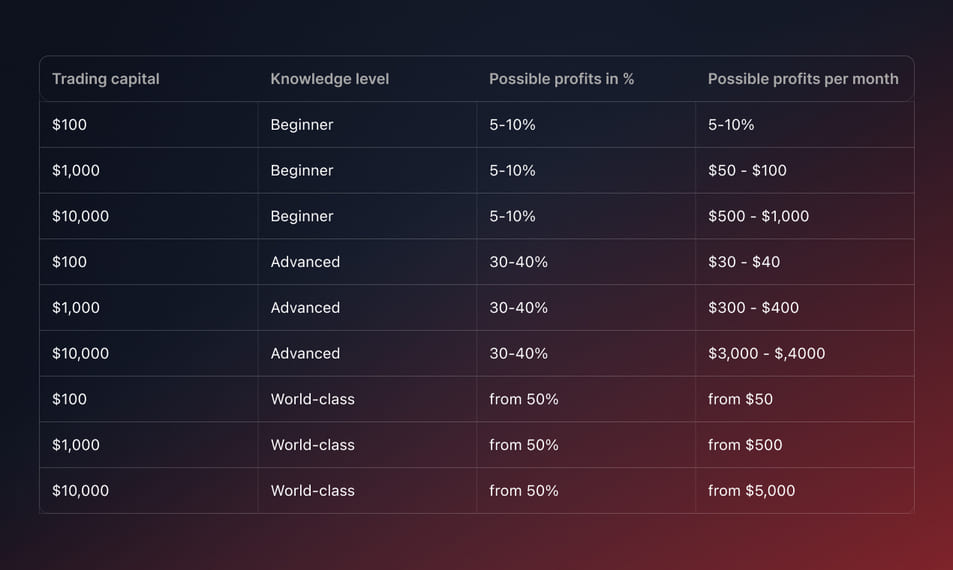
Is Forex Trading Profitable in 2024?
Contents
Can I get profit from trading on the Forex market? That is one of the most common questions of newcomers. Yes, traders are able to earn a living from Forex; meanwhile, there are a lot of “buts.”
In this article:
- How much does an average Forex trader earn?
- What do profits depend on?
- Which recommendations do help traders stay in the black?
- What are the most profitable trading styles?
The vast majority of beginner traders set unreal goals, and that is among the crucial mistakes that lead to heavy losses.
How Much Do Forex Traders Earn?
Fraudsters who are selling “online magic tutorials” and promise golden mountains assure their clients that a trader may easily earn $1 million and even more. But let’s come down to earth and discover some real statistics.
According to ZipRecruiter, an average US Forex trader earns $101,533 per annum which makes the medium trader’s salary $48,81 per hour.
Of course, there are many traders who earn millions of dollars, and that sounds quite real, but you need to upgrade your skills, augment your goals gradually. When a newcomer enters the market with a “get-rich-quick-scheme,” sooner or later he will face losses.
Let’s explore other numbers related to how much a Forex trader earns. According to statistics, from 90% to 95% of newbies making their first steps in the niche completely lose their first deposits. They make one and the same mistakes. When entering the market, you need to understand that Forex is more like work, not a gold mine where money falls from the sky.
Factors that Affect a Trader’s Profits
Traders may get $300 per month or $400,000 per week. Much depends on the following factors:
Trading style
There are four main trading styles: scalping, intraday trading, swing trading, and position trading. Earnings depend much on which style a trader prefers; meanwhile, the risks vary as well.
Scalpers aim to open a lot of positions for short periods of time, usually for several minutes. They get minimum profits, from 0.5% to 2% from a deal. Furthermore, some deals are losing, and that is understood as something normal.
Intraday traders earn from 2% to 5% from a deal. They open a lot of positions as well, and the main rule lies in closing all the positions within the same day.
Swing traders who hold their positions for days or even weeks, may get 10%-30% from a position. They put an accent on quality, not quantity.
You may also like

As for position trading, they act more like investors – holding a position for weeks, months, or even years is a common thing for this style.
Trader’s deposit
The more you invest in Forex trading, the higher profits you expect to get. For instance, a scalping trader may get from $0.5 to $2 from a deal when investing $100. With the capital of $10,000 the same trader earns from $50 to $200 from a position.
On the other hand, that doesn’t mean traders should invest as much as possible. They need to take into account the risks and find the balance between possible profits and potential risks.
Leverage
The vast majority of traders prefer to use leverage and multiply their initial funds in order to get higher profits. In this situation, traders need to find the balance as well. On the one hand, leverage truly opens more possibilities for a trader. On the other hand, too high multipliers easily eat your deposits up; which is why leverages more than 1:100 are exceptionally dangerous.

Knowledge
Beginners who understand the market mechanisms and some basics usually earn from 5% to 10% per month. Traders with advanced skills who utilize most of the market indicators and patterns correctly may earn up to 30-40% per month. When talking about world-class traders, their earnings surpass 50% monthly.
Top 5 Ways to Make Forex Trading Profitable
Forex trading is enough to earn a living when a trader is striving the right path. What are the ways that make trading profitable?
Diversification
Diversification is the lifeline for both investors and traders. They say not to store all the eggs in one basket. When there are some problems in one market (e.g., AUD/USD), traders get profits from another pair (GBP/JPY). Professional Forex traders open positions with diverse trading pairs.
Emotionless trading
Human beings are emotional creatures, we are not robots. Meanwhile, emotions may spoil our trading plans, as a beginner trader frequently opens positions being affected by fear, euphoria, etc. In such cases he ignores trading plans, risk management, and loses his funds. We cannot turn off the emotions, but professional traders understand both profitable and losing deals as integral parts of their work strictly following their trading plans.
Trading plan
You cannot trade chaotically and get stable profits. Experienced traders rely on a trading plan where all the grounds are stated. What does a trading plan include? Here are the core elements:
- trader’s objectives;
- entry and exit conditions;
- preferable markets and assets;
- possible leverage;
- risk-management rules;
- trading strategy.
Furthermore, a trading plan can include some more elements added by a trader individually.
Trading strategy
Professional traders never open positions based on their intuition or luck. A trading strategy is a set of entry and exit conditions traders rely on when setting new orders. Such a strategy consists of the following components:
- Assets that match the strategy. For instance, a certain strategy is effective for volatile trading pairs only.
- Timeframes. The effectiveness of a strategy depends much on which timeframe a trader selects. Some strategies are more effective on lower time frames, others – on higher ones.
- Instruments. A set of technical analysis indicators, graphic figures, and patterns are the basis of every trading strategy. Traders utilize the given instruments and understand when they should open a position and where the exit point is.
Constant development
To stay in the black, you need to develop your trading skills constantly. Financial markets constantly change; therefore, traders need to adapt to new conditions, find some new effective strategies, and so on.
Even the most successful traders are going to end so badly when they do not accept new game rules and utilize their old knowledge.
Risk Management Principles as the Basis for Profitable Trading
What does risk management mean and why is it important? The core goal of risk management lies in taking your risks under control and understanding how to spread risks alongside all the positions.
You may select one of the following risk management approaches:
- The fixed amount for one position. Traders use one and the same amount of money for every position no matter what are the results of previous deals. For instance, you’ve deposited $100, and invest $5 in every position.
- The fixed percentage of the overall deposit. Such a risk management strategy is the most widespread one chosen by both newcomers and professional traders. According to this approach, traders invest from 1% to 5% from the overall deposit to open a position. Professional traders use 3-5% of their deposits when beginners are recommended to start from 1-2%.
- Mathematical strategies. Those strategies came from casino games and forced traders to increase investments after losing deals. On the one hand, one successful deal makes it possible to get back everything you’ve lost. On the other hand, risks are exceptionally high, and unfavorable conditions lead to the losing of your deposit.
What is the best risk management strategy? There is no exact answer. Traders select a strategy that fully corresponds to their trading style and expectations.
Mistakes that Make Forex Trading Unprofitable
Why do traders lose their money? There are hundreds of reasons but here are the most common mistakes that lead to losses:
- Opening too many positions.
- Trying to recoup losses as quickly as possible.
- Neglecting risk management and money management.
- Ignoring market conditions.
- Trading without any system and plan.
- Blindly copying trades of other market players.
- Not fixing losing positions.
- Trading under emotions.
The above-mentioned mistakes are common for all newcomers and lead to 70-80% of losing deals beginner traders face.
Step-by-step Guide on How to Make Forex Trading Profitable
- Sign up for a brokerage company that offers the best trading conditions (the array of assets, fees, analytical instruments, educational materials, and more).
- Create a demo account to understand how the market works. Get your first virtual deposit and open some 2-3 positions to test the mechanisms.
- Build your trading plan thoroughly and decide on which strategy you are going to select.
- Test the chosen strategy on a demo account.
- Define risk management and money management principles you are going to follow.
- Ensure that you get profits and the chosen strategy is rather effective. Switch your trading regime to the real one.
- Make your first deposit. Invest the minimum acceptable amount, that is enough for beginners.
- Open positions for $1 following the same principles as on a demo account. Make sure you get stable profits.
- Increase your investments gradually to get stable profits from trading.
- Test new strategies on a demo account, upgrade your skills in technical and fundamental analysis, follow the financial news to keep up with the times and stay in the black.
What are the Limits?
How much can a trader earn in the Forex market? As we already mentioned, profits depend much on your initial deposit, knowledge level, and trading style. Let’s build a table that illustrates average profits of different traders.

Bottom Line. Is Forex Trading Still Profitable?
An average Forex trader (professional and experienced) earns more than $100,000 per year; meanwhile, beginners need to have realistic expectations. Forex trading is not a kind of magic that brings millions without any effort. Trading is more like work that requires time, knowledge, and constant development.
Updated:
December 19, 2024
19 December, 2025
Top 10 White Label Casino Providers 2026
A white label casino is a ready-made online gambling platform that lets entrepreneurs start their own brand without building technology or securing licenses from scratch. In 2026, this model remains the fastest and most affordable way to enter the iGaming market. The leading white label casino providers in 2026 are SoftSwiss, BetConstruct, NuxGame, SoftGamings, FintechFuel, […]



